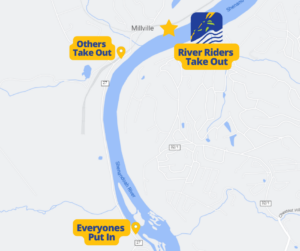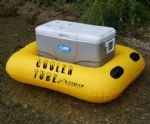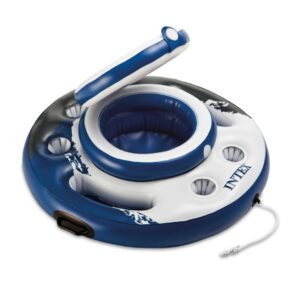We have the longest trips in the area! Your whitewater tubing trip is 1.5 miles longer (by about a 1/3). The flatwater Shenandoah River tubing trip is also the longest. River Riders has acquired a personal private river access just above Harpers Ferry. This access is only 2 miles and less than 5 minutes from our base. This means less bus time and more tubing time for you. Your new trip has 30% more whitewater fun!
River Riders is the ORIGINAL Harpers Ferry tubing company. We serve thousands of guests over the year and take several hundred people per day on weekends. Although you may experience some wait time on weekends, we are committed to providing you with a quality experience. We offer upgraded vinyl tubes for a more comfortable and durable option and we are the only outfitter to offer Tube Tracker Pro’s with a paddle!
White water tubing trips go on the Potomac River from our private Bakerton Rd River Access above Harpers Ferry to *Potomac Wayside floating by Harpers Ferry, a total of 5 miles which is 1.5 miles longer than other trips.
Potomac Wayside takeout is just above the historic district of Harpers Ferry along the right side of the river before the Green Potomac River Bridge. Click on the map for a larger view.
Flat water Shenandoah River tubing trips trips vary depending on the water levels, but the standard trip is from the Millville Dam down to the River Riders rafting put-in about 2.5 miles and takes about an hour and a half to 3 hours. The flat water trip does not pass Harpers Ferry. River Riders has the longest flat water tubing route in Harpers Ferry!

The rapids on the white water tubing trip are class I-III at normal water levels. American White water terms class I-III as beginner to intermediate level rapids. Here is some information taken from the International Scale of River Difficulty.
Class I: fast moving water with riffles and small waves. few obstructions, all obvious and easily missed with little training. risk to swimmers is slight; self-rescue is easy.
Class II: novice. straightforward rapids with wide, clear channels which are evident without scouting. occasional maneuvering may be required, but rocks and medium sized waves are easily missed by trained paddlers. swimmers are seldom injured and group assistance, while helpful, is seldom needed.
Class III: intermediate. rapids with moderate, irregular waves which may be difficult to avoid. strong eddies and powerful current effects can be found, particularly on large-volume rivers. injuries while swimming are rare; self-rescue is usually easy but group assistance may be required to avoid long swims.
The trips are successfully completed by thousands of people each year, but they are not without danger or difficulty. If you are unsure of your ability, the flat water tubing trip option may be a better choice for you.
The flat water trip generally contains moving current, but no rapids. It is suitable for most guests including children ages 4 and up. This is a relaxing float trip sometimes referred to as a “lazy river float trip”, not an excitement trip. Please be aware however, that as with all water and outdoor activities, this trip is not without risk.
Water levels locally can fluctuate and change the look of the river and your trip with us. Water levels are typically higher in the Spring than in the summer season depending on local rainfall.
Check out the water levels:
Shenandoah River at Millville Gauge – Flat water Tubing trips
Potomac River at Point Of Rocks – White Water Tubing trips
For white water tubing, our requirement is 10 – 12 years and about 5 feet tall to effectively reach the water to steer and paddle yourself; for flat water tubing, riders should be at least 4 years and 30 lbs.
These are just recommendations, and decisions will have to be made by the participants as to individual suitability.
We always reserve the right to change these ages if river conditions warrant it.
Trip times vary depending on water levels, trip length, and participant behaviors.
That being said, when you go on the river on your own as most people do, people take considerably different amounts of time to do the same trip. On average, the whitewater trip takes 2 hours to float straight from the put-in to the take-out without paddling yourself down the river. The flat water trip takes about 2.5 to 3 hours hours without paddling yourself down.
Yes, our tubing trips require shoes that have straps that will stay on your feet. We recommend water shoes, or an old pair of tennis shoes. Flip-flops or bare feet are not permitted.
Yes, at normal water levels, coolers can be brought on the trips. We allow one cooler per five people on flat water and one per ten people on whitewater. We reserve the right to limit this further because of water levels or any other factors.
Please bring only canned or plastic items in the coolers to avoid the possibility of the item breaking. We do not allow styrofoam coolers on the trips because they tend not to hold up to the rigors of floating down the river. We rent cooler tubes to put your own cooler in. We also sell floating coolers that you can put your items directly inside of.
A “cooler tube” is a yellow, vinyl, rectangular tube for your own cooler. We rent them for $19 each.

A “cool float” is an inflatable, round, vinyl cooler with a lid that secures and floats. Cooler float options are listed below. 16-quart Cool Floats hold up to 18 cans inside and 4 cans outside plus ice.

Alcohol Policy: Small amounts of alcohol are technically allowed by law. However, it is illegal to operate a vessel (Tube) while under the influence of alcohol (BAC 0.08) or a controlled substance. The Maryland and West Virginia DNR’s are responsible for patrolling and can issue citations much like a DUI. The maximum penalty for an offense is $500 and two months in jail. The white water tubing take out is National Park property and open alcoholic containers are prohibited. You will be tubing in a natural environment. On the whitewater trip, you will have to navigate through rapids. You need to have your sense about you. Being intoxicated greatly increases the chances of drowning or having another incident on the river. We reserve the right to restrict coolers on trips due to water levels and refuse service to any guest who appears intoxicated.
Be responsible.
See our Harpers Ferry location page for detailed directions.
You will be provided with a type III Personal Floatation Device or PFD similar to a water skiing PFD. Without a doubt the best thing you can do to help assure your safety if you fall out of your tube is to wear your PFD. Grab onto your tube as soon as possible and try to get back onto it. If you can not get back onto your tube while in the water find a large rock or the shore to stop and get back on. If you are floating through rapids lay on your back with your feet downstream of you until you reach calmer water. Do not try to stand up if you are in moving current that is deep enough to float in.
It is important to keep your tube with you the entire trip. If you do end up losing it, try to get it back as quickly as possible. If you are with a group you should always try to stay together so that you can help each other out. If you are separated somehow, find a good spot to get out of the river. Do not take any chances if the tube is in a rapid or if you are not sure that you can get to it. Although you are responsible for bringing your tube back, it isn’t worth risking yourself to get a tube that is in a potentially dangerous location. The best way to avoid all of this is if you flip off your tube, grab it as soon as you come up to the surface. It will almost always be right beside you. The longer you wait to grab your tube, the more likely you are to lose it.
In the unfortunate event that you pop your tube, you have several different options.
First, remember that the trip is on your own so there won’t necessarily be any River Riders’ staff on the river near you. The most popular method of getting another tube is to find someone with a cell phone either on the river or on the shore and ask them to call our office at 304-535-2663. If we bring a tube to you, it can take up to an hour for us to reach you depending on where you are on the river.
Another popular method is to climb on a friend’s tube and go down together. This generally works best for people who are small and flexible.
Other good options include getting out on the side of the river and flagging down one of our drivers to get another tube. Remember to think about your location before you do this. It is very important that you get out on the side of the river where the road is, and that the section of the river you are on has a road next to it. Fortunately, there is road access along most sections of the tubing trip. If you aren’t sure, climb out on the shore and survey the situation. You may have to walk a ways to find the road, but never leave the river very far. Walk along the shore until you find the road. The roads in this area are windy and visibility is often limited. Stay on the side and be aware of cars. If you are on a section that has train tracks, they are in use. Be very aware of trains as they don’t always make much noise and are often traveling fast. You can also call us at 304-535-2663.
The final option is to swim/hike your way to the take-out. Do not swim unnecessarily through rapids. Get on rocks or the shore and walk around them. Whenever you are in calm pools or flat section, you can float with your PFD downstream. Just be aware on the whitewater trips that more rapids lay ahead, and you’ll have to get back out to walk around them. Use this method only as a last resort.
Please don’t leave any deflated tubes in the river. Bring them with you to your pickup point. If you do this, you most likely will not be held responsible for damaging it.
The rivers are a natural environment and home to many animals. In the water you could see fish, turtles, frogs, and rarely a non-poisonous water snake. We have never had a single person have any type of bad interaction with an animal on the trip. They are more scared of you than you are of them. Just use caution if you see one and slowly back away. They will continue about their business as if you weren’t there.
During the summertime, it is common to have afternoon thunderstorms. The odds of being struck by lightning are very low. Lightning strikes, while not common, can be deadly, so guests should still act with caution. Storms tend to last 10-15 minutes and subside. We recommend getting out of the water and waiting a storm out. The best spots while on the trip are under a bridge or aqueduct along the river if you can’t get to a shelter or the end of the trip. After the storm passes continue your trip as planned.
You should not stand near the highest object in the area and try not to stand immediately next to any large trees. Find a clearing. If you are near a road do not get out in the middle of the road with your tubes. You run the risk of being hit by a car. If necessary we will send out vehicles for assistance.
You can find additional helpful information here: Lightning Safety on River Trip from NOAA
The safety video and the driver will show and/or explain the take-out to you on the way to the put-in. If you have any questions at all about where you are getting out, be sure to ask your driver. It is your responsibility to understand where you are getting out. Here is the Potomac River Tubing map for a visual map.
You will have to go back and find it. Be sure you understand what the driver has explained about landmarks indicating the ending point. If you miss the end point, you will have to hike back along the shore until you get to it. We don’t have the ability to pick you up in roadless areas that occur beyond the take-out points.
River Riders Bus Timing varies. Good communication with your driver is very important. Please bring a waterproof watch along. On weekends, we have buses that drivers loop between the shop and the put-ins and take-outs. We strive to be at the pickup points between every 1/2-hour to an hour. Be aware that especially on Saturdays and sometimes Sundays from mid-June through mid September there may be a wait. Please be patient.
Good times to be at the endpoint for white water tubing on weekends are 1 pm, and 3:30 pm to 5 pm. The most common wait time for whitewater tubing is between 1:30 and 3 pm because of shuttle timing.
Good times to be at the endpoint for flat water tubing on weekends are 2 pm to 3 pm and 4:30 pm to 5 pm. The most common wait times for flat water tubing are between 1:00 and 2 pm and 3:15 to 4:30 pm because of shuttle timing.
All buses are on the road non-stop during busy times and will pick you up as soon as possible.
Keeping your group organized, such as keeping everyone together, and stacking tubes neatly on the side will help the drivers to keep moving during busy times.
The drivers are working hard to provide you with the best possible service.
It depends..
For full day tubing, both the white water and flat water trips are included.
White water trips include only one shuttle. You can stay out until the last pick-up time. You are welcome to walk back up and run rapids more than once, but you only get one ride. You may stop along the way on rocks, etc. You should ask your driver what trip we are running on the day of your trip. It is normally decided that morning depending upon water levels and other factors. You only need to be sure that you are at the pick-up points on time.
*The last shuttle pick-up of the day is 5:30 pm on Weekends, 5pm on Weekdays.
Flat water trips that are run on the regular flat water section can be run more than once if the timing allows for that day. If we run the trip on a different section due to high water levels or any other reason, we may allow multiple runs as well. Ask your driver before the drop-off for details.
*The last shuttle pick-up of the day is 5:30 pm, 5pm Weekdays.
Yes and No. Having a longer rope in moving water is a safety hazard. If your rope were to get tangled in something you could get caught in it and be pulled underwater or trapped. If you need to stay close together just periodically put your hands on each other’s tubes on the white water tubing trip.
We do have tube tethers available for purchase at our main retail shop, which are very short so that they don’t dangle in the water.
If you have small children we have double tubes that can be reserved in advance. They are only suitable for an adult and a small child or 2 smaller children. They are not large enough for 2 adults.
River Riders only offers the best quality vinyl (PVC) tubes designed for river use. We have several different models to suit guests’ needs.
The Standard Tube is made out of a heavy gauge vinyl fabric specifically made for river use. It is a heavier fabric than a vinyl “swimming pool” tube and therefore stands up to more use. It is more comfortable and durable than a basic black rubber tube and has handles.
The Deluxe vinyl tube is also made out of a heavy gauge vinyl fabric specifically made for river use. It is more comfortable and durable than the basic tube. It too has handles but also a seat bottom, cup holder, and backrest. The Deluxe tube is $5 more to rent than the standard vinyl tube.
The Tube Tracker is made out of a heavy gauge vinyl fabric specifically made for river use. It is more comfortable than the standard tube and comes with a light-duty paddle. It also has handles but also a seat bottom, cup holder, and backrest. The Tube Tracker is $5 more to rent than the deluxe vinyl tube.
We do allow dogs on flat water if you provide your own transportation and a PFD, but we recommend that you do the Potomac Play Pass as an alternative activity that is better suited. The Potomac Play Pass has canoes, kayaks and paddleboards available on a lake-type setting which is a great option for bringing our furry friends.
River Riders, Inc.
408 Alstadts Hill Rd.
Harpers Ferry, WV 25425
Shenandoah and Potomac Rivers
Call or text:
304-535-2663
Stay connected with the latest news at River Riders. Subscribe today!